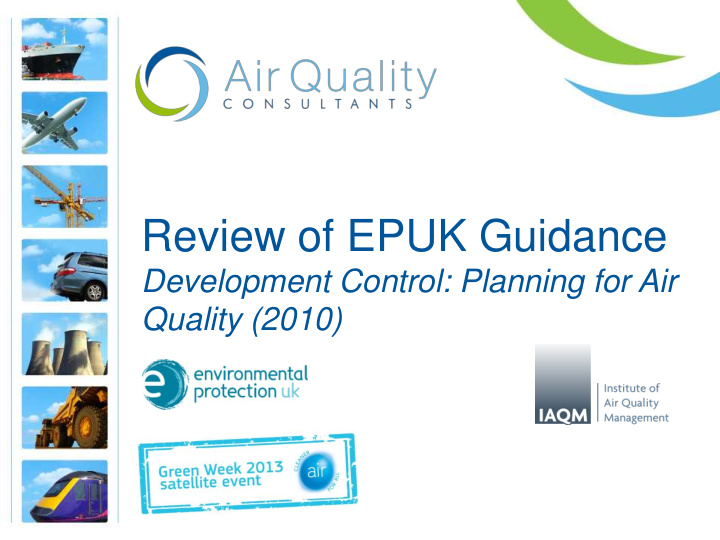



Review of EPUK Guidance Development Control: Planning for Air Quality (2010)
Background • Development Control: Planning for Air Quality published by NSCA in Nov 2004 • Minor revisions issued in 2006, followed by a more detailed update in 2010
Background • Guidance was developed to fill a gap in that provided by Government • Defining a uniform approach was thought to be useful to both developers and local planning authorities • Guidance often relied upon at public inquires (in the absence of statutory guidance) and has been tested • Elements of the guidance have been adopted into a number of local authority SPG/SPD
Significance Criteria • Significance criteria needed to be reviewed during the 2010 update • Considered that this would most appropriately dealt with by the organisation representing air quality professionals – IAQM • Description of air quality impacts and the assessment of their significance was published by IAQM in 2009, and subsequently incorporated into EPUK guidance
Taylor Review • Review of Planning Practice Guidance led by Lord Taylor reported a number of recommendations in December 2012 • Identified priorities for new and updated guidance, including environmental issues such as air, water and noise • This updated guidance will be short, non- prescriptive and cannot make specific reference to non-statutory guidance
What needs to be considered? • Elements of 2010 EPUK guidance that are out of date, and perhaps do not reflect best practice • NPPF, construction dust etc. • More detailed consideration of non-traffic sources? • Lessons learned from practical experience – what works well, and what does not?
Some feedback • Emissions vs Concentrations • Many schemes generate changes in concentrations that are classified as imperceptible to small , and impacts that are judged to be negligible to slight adverse. • Does this provide sufficient incentive for mitigation where objectives are exceeded? • Cumulative effect of many small schemes?
AQ Assessments for EIA • EIA Regulations state “ development consent for public and private projects which are likely to have significant effects on the environment should only be granted after an assessment of the likely significant environmental effects has been carried out ” • In other words, there is a legal requirement to determine significance of effect • Can you carry out an assessment of the effects based on emissions calculations alone? • How does an emission quantify an effect? • Emissions poorly related to exposure
Judgment of significance • Judgment of significance based on more than the magnitude in change in concentrations Factors Number of people affected by increases and/or decreases in concentrations and a judgement on the overall balance. The number of people exposed to levels above the objective or limit value, where new exposure is being introduced. The magnitude of the changes and the descriptions of the impacts at the receptors Whether or not an exceedence of an objective or limit value is predicted to arise in the study area where none existed before or an exceedence area is substantially increased. Whether or not the study area exceeds an objective or limit value and this exceedence is removed or the exceedence area is reduced. Uncertainty, including the extent to which worst-case assumptions have been made The extent to which an objective or limit value is exceeded, e.g. an annual mean NO 2 of 41 g/m 3 should attract less significance than an annual mean of 51 g/m 3
Updating the guidance • Ensure that guidance does not contradict itself • Preserve the element of professional judgement • Concluding a development does not have significant effects does not mean that additional environmental controls cannot be required – options not necessarily mutually exclusive
Land Use Planning is a Determinant of Air Quality • Assessing significance of effects is not a substitute for good policy making • Planning policies and development plans are instruments that can determine future air quality • 2010 Guidance states “ The spatial planning system has an important role to play in air quality and reducing exposure to air pollution. Both the development of local planning policy and the determination of individual planning applications are important, the former setting the framework for the latter. This guidance focuses on development control but also stresses the importance of having good air quality policies within the local development framework ”
Questions • Do we want “national” guidance on AQ and development control? • What works well in existing guidance? • Better consideration of non-traffic sources? • What problems have been encountered from practical experience? • What changes need to be made – and how will we go about it?
Let’s Discuss!
Recommend
More recommend